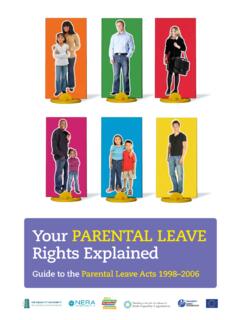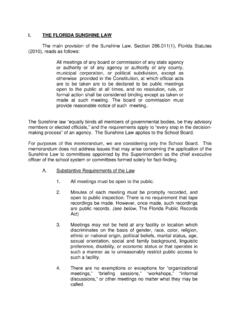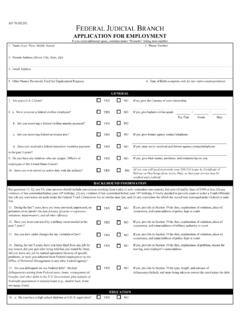Transcription of EMPLOYMENT LAW EXPLAINED V4 240918.qxp Layout 1
1 Starting EmploymentDay five statementWithin five days of starting work, all employees must get a written statement of the following core terms of EMPLOYMENT :1. the full names of the employer and the employee2. the address of the employer3. the expected duration of the contract, in the case of a temporary contract, or the end date if the contract is a fixed-term contract4. the rate or method of calculation of the employee s pay5. the number of hours the employer reasonably expects the employee to work per normal working day and per normal working weekThis is as well as the full written statement of terms of EMPLOYMENT which must be given within two months of starting the Minimum WagesPay/WagesUnder the new EMPLOYMENT Miscellaneous Provisions Act 2019 wage rates for employees under 18 and those over 18 have been simplified and will be solely based on age. Trainee rates of pay have been EMPLOYMENT OrderA Sectoral EMPLOYMENT Order (SEO) setting legally binding rates of pay and terms and conditions for the Electrical Contracting sector came into effect on the 1 September to EMPLOYMENT Law ExplainedSince we published our EMPLOYMENT Law EXPLAINED in September 2018 there have been changes under EMPLOYMENT law.
2 Below your will find the latest HoursZero HoursThe Organisation of Working Time Act 1997 (OWTA) is amended to prohibit zero hour contracts except in the following circumstances: where the work is of a casual nature where the work is done in emergency circumstances where short-term relief work is used to cover routine absences for the employerMinimum payment in certain circumstancesA new minimum payment will apply when an employee on a zero hours contract, is called in to work and does not receive the expected hours of minimum payment is calculated as three times the national minimum hourly rate of pay or three times the minimum hourly rate of pay set out in an EMPLOYMENT Regulation Order (if one exists for that sector and for as long as it remains in force).The already existing method of payment (at least 25% of the contract hours or 15 hours) continues to apply Hours provisions Employees whose contract of EMPLOYMENT or statement of terms of EMPLOYMENT does not reflect the reality of the hours they habitually work are entitled to request to be placed in a band of hours that better reflects the hours they have worked over a 12-month reference period.
3 If you are an employee, you must be working for your employer for at least a year before making this requestAnnual leave and certified sick leaveFrom the first day in a job employees are building up holiday entitlements even if they are on certified sick leave and whether they are part-time or full time. If an employee is on certified sick leave at the end of the leave year the annual leave they have earned and have not been able to take is carried over and available to take for the next 15 months. Family friendly leaveMaternity leave and premature birthMothers of premature babies born over two weeks before their due date are entitled to extend their maternity leave by the difference between the birth date and the date maternity leave was due to start. Ordinarily maternity leave commences no later than two weeks before the due date. Paternity leavePaternity leave of two weeks is available to a relevant parent within 26 weeks of the birth of their child.
4 A paternity benefit payment is available for qualifying relevant parents from the Department of EMPLOYMENT and Social hours6 hours11 hours16 hours21 hours26 hours31 hours36 hrs & overTo6 hours11 hours16 hours21 hours26 hours31 hours36 hoursParental leaveThe maximum period of parental leave increased from 18to 22 weeks from 1 September 2019, and increases againto 26 weeks from 1 September 2020. The age of the childfor which parental leave is available has increased from 8to 12 years. For a child with a disability the parental leaveage threshold remains unchanged and is available up to theage of our website for more detailedinformation or call our information service on 0818 80 us on Twitter @WRC_iePublished September 20191 Contents PAG E INTRODUCTION2 SUMMARY OF EMPLOYERS OBLIGATIONS3 WRC INSPECTION SERVICES4 SUMMARY OF INSPECTORS POWERS4 RECORD KEEPING5 FIXED-TERM EMPLOYEES/ TEMPORARY AGENCY WORKERS8 EMPLOYMENT STATUS OF EMPLOYEES7 PART-TIME EMPLOYEES10 EMPLOYMENT OF YOUNG PERSONS10 EMPLOYMENT OF FOREIGN NATIONALS13 WRITTEN TERMS AND CONDITIONS16 PAY AND WAGES18 HOLIDAYS, BREAKS, REST TIME19 PROTECTIVE LEAVE21 EQUALITY22 SPECIFIC INDUSTRY AGREEMENTS23 TERMINATION OF EMPLOYMENT24 REDUNDANCY25 CODES OF PRACTICE AND OTHER REQUIREMENTS26 APPENDIX I: ORGANISATIONS THAT CAN ASSIST WITH EMPLOYMENT30 ENFORCEMENT27 APPENDIX II.
5 USEFUL PUBLICATIONS33 SEPTEMBER 2018 IntroductionOne of the key objectives of the Workplace RelationsCommission (WRC) is to provide impartial information on awide variety of EMPLOYMENT rights legislation to employers andemployees by telephone, in writing, through its website andthrough ongoing public awareness programmes. The WRC alsoprovides an extensive range of explanatory leaflets and acomprehensive Guide to EMPLOYMENT , Labour and Equality publication aims to help employers to comply with theirobligations under EMPLOYMENT law. When setting up or runninga business with paid employees, employers should be familiarwith a number of basic provisions under Irish EMPLOYMENT summary guide has been produced by the information on EMPLOYMENT rights is available or by contacting the Commission sInformation and Customer Services at Lo-call 0818 808090 note that this is not a legal interpretation of the of Employers Obligations An employer is responsible for ensuring that their employees receive certain basic EMPLOYMENT rights.
6 The main obligations include: lTo only engage employees who have permission to work within the State, lTo ensure that they provide employees with a written statement of terms and conditions of EMPLOYMENT , lTo give employees a written statement of pay or payslip , lTo pay employees not less than the statutory minimum wage rates, lTo comply with the maximum working week requirements, lTo provide breaks and rest periods during working hours, lTo give annual leave from work, lTo give a minimum amount of notice before termination of EMPLOYMENT , lTo maintain records in relation to their employees and their entitlements. For further information download the Guide to EMPLOYMENT , Labour and Equality Law at A list of Guides, Leaflets and Explanatory Booklets for specific areas of EMPLOYMENT law is available at Appendix II. 3 WRC Inspection ServicesThe WRC is also responsible for monitoring a range ofemployment rights in Ireland through its Inspection Inspectors operate in a fair and impartial manner, carryingout inspections throughout the country.
7 These inspections ariseas a result of complaints received of alleged contraventions ofemployment rights, as a result of targeted inspectioncampaigns and as a result of routine inspection evidence of non-compliance with EMPLOYMENT rightslegislation is found, the inspector s main priority is to have thematter rectified. In some cases the issue of compliance and/orfixed payment notices and/or the initiation of prosecutionsagainst the employer may be of Inspectors PowersIn general WRC Inspectors have the following powers underlegislation:lTo enter any place of work at a reasonable time,lTo require the production of records,lTo inspect records,lTo take copies of, and remove and retain, records,lTo interview and require information from any a list of the records to be made available for WRCI nspectors, see the section on Record Keeping on page [5].The WRC s Inspection Services can be contacted onTelephone: (059) 9178800Lo-Call: 0818 2201004 Record Keeping The following list sets out the standard records which employers must keep and to which a WRC Inspector will require access during the course of an inspection:- completed template sent with the inspection appointment letter or the same information in a similar format.
8 Registration number with the Revenue Commissioners. of all employees including full name, address and PPS number for each employee (full-time and part-time). terms of EMPLOYMENT for each employee. details (including Gross to Net, Rate per hour, Overtime, Deductions, Shift and other Premiums and Allowances, Commissions and Bonuses, Service Charges, etc.). that the employer has provided payslips to employees. job classifications. of commencement and, where relevant, termination of EMPLOYMENT . of work for each employee (including starting and finishing times). 10. Register of employees under 18 years of age. 11. Details of any board and/or lodgings provided to employees. 12. Holiday and Public Holiday entitlements received by each employee. 13. For non-EEA nationals1, EMPLOYMENT permits or evidence that permits are not required. 14. Any documentation necessary to demonstrate compliance with EMPLOYMENT rights legislation. Additional records may be required to be held depending on the sector/business involved.
9 There are minimum periods for which these records must be kept (generally three years).61 The EEA (European Economic Area) comprises the member states of the European Union together with Iceland, Norway and Status of Employees Employers engage persons on either contracts of service or contracts for services. Only a person engaged under a contract of service is deemed to be an employee and therefore protected by the full range of EMPLOYMENT legislation; an independent contractor or self-employed person will have a contract for services with the party for whom the work is being done. The distinction between a contract of service, on the one hand, and a contract for services, on the other, is sometimes unclear but the type of contract a person is engaged under can have serious implications for both employer and employee in matters such as EMPLOYMENT protection legislation, legal responsibility for injuries caused to members of the public, taxation and social welfare.
10 For further information, please see the Code of Practice for Determining EMPLOYMENT or Self- EMPLOYMENT Status, which can be downloaded from If you require more detailed information on the insurability of EMPLOYMENT and self- EMPLOYMENT please contact: Scope Section Department of EMPLOYMENT Affairs and Social Protection Gandon House Amiens Street Dublin 1. Telephone: (01) 6732585 Email: 7 Fixed-Term Employees/ Temporary Agency Workers Depending on business needs, companies may require to take on part-time employees, fixed-term employees or temporary agency workers. Fixed-Term Employees: A fixed term employee is someone who is employed under a contract which contains a specific start and end date or who is employed to carry out a specific task or project or the continuity of whose contract is contingent on a particular event such as the availability of continued funding from an external source. Fixed-term employees cannot be treated in a less favourable manner than comparable permanent employees in relation to conditions of EMPLOYMENT and all employee protection legislation, other than that relating to unfair dismissal in certain circumstances, applies to fixed-term employees in the same manner as it applies to a permanent employee.












